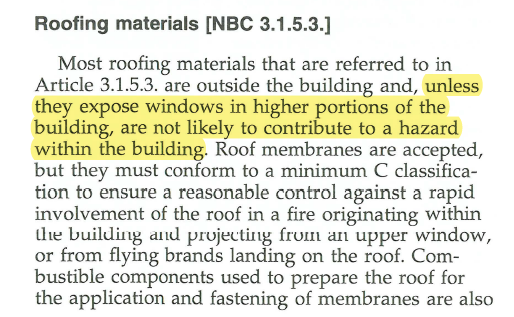Article 3.1.5.3. provides allowances for roofing materials in a building required to be of noncombustible construction.
I’m working on a project where the roof of the 2nd storey is a central rooftop patio for various areas of the 3rd storey in a building which is required to be of noncombustible construction. When reviewing this project, I had a look back at the NRC 95′ User’s Guide to the NBC, and found this:

After reading this, I was even more confused about the application of Article 3.1.5.3. My questions are this:
- If a roof assembly as a whole (sheathing,insulation,roof covering,etc) has a Class A, B, or C classification as required in Sentence (1)… is Sentence (2) for roof sheathing still applicable?
- Based on the commentary in the users guide, should allowances in 3.1.5.3. be permitted in lower roof portions of buildings with non-contiguous roofs at different elevations? Having roofs at different elevations, and roof top amenity spaces within the building area are quite common.

One Response
Re your #(1), as we understand it, the provisions in Sentence 3.1.5.3.(2) [NBC 2015] are not affected by the provisions of Sentence (1).
The ‘false’ roof system (permitting use of combustible sheathing and supports) implicated in Sentence (2) would still be required to have a Class A, B or C roof covering.
Re your #(2), as we understand it, it is only the provisions of Article 3.2.3.15 [NBCC 2015] that consider the fire exposure hazard of roof assemblies located adjacent to other higher portions of the subject building, and only as it relates to the presence/proximity of skylights within the lower roof portion, when there are windows in adjacent wall portion of the upper storeys.